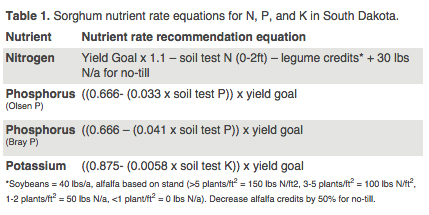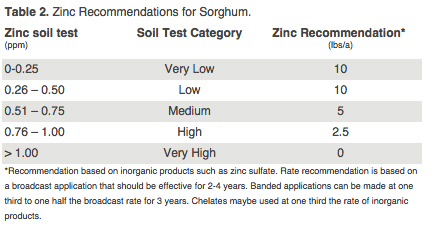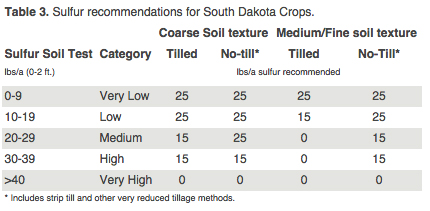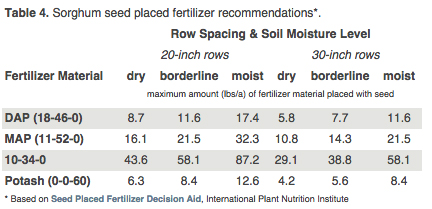Sorghum can overcome water stress better than corn and therefore is considered a preferable crop choice in drier climates.
The importance of knowing and applying the correct nutrients is both economically proficient and demonstrates environmental stewardship.
Nitrogen, Phosphorus & Potassium
The nitrogen (N) requirements of sorghum are 1.1 lbs N/bu grain yield used in combination with all the credits that include soil test nitrate (0-2ft), legume credits for soybean (40 lbs N/a), alfalfa and other legumes.
Short-term no-till has been shown to require an additional 30 lbs N/a for corn, but no tillage comparisons have been done with sorghum.
Phosphorus (P) requirements for sorghum are slightly less than corn. A 100 bu/a sorghum yield goal at the “low” P soil test requires 44 lbs P2O5/a while corn is 46 lbs P2O5/a.
Potassium (K) requirements for sorghum are about 50% of corn at the “medium” K soil test level and about 75% at the “very low” level. Equations for determining N, P and K nutrient recommendations for sorghum can be found in (Table 1).
Zinc
Zinc requirements for sorghum and corn are similar (Table 2). Soil test zinc above 1.0 ppm does not require any fertilizer zinc additions to the soil.
Sulfur
Little is known about sorghum’s response to soil sulfur (S). Given the slightly less N needs by sorghum when compared to corn, one would assume that sulfur needs are also somewhat less, because the ratio of N:S in most healthy crop plants is roughly 12-16:1.
Therefore, if soil test sulfate-S in the top 0-2 ft. layer is less than 40 lbs/a, additions of fertilizer sulfur to the soil should be considered (Table 3).
Other Considerations
Sorghum is not known to respond to additions of chloride (Cl) to the soil. Magnesium (Mg), calcium (Ca), iron (Fe), boron (B), copper (Cu), and manganese (Mn) are not known to cause crop nutrient deficiencies in South Dakota and should not be a concern for sorghum.
Seed-placed fertilizer for sorghum needs to be considered, as it’s more sensitive than corn. The variables that control the fertilizer rate applied in the seed furrow are the fertilizer material, row spacing, soil moisture at planting and allowable stand loss.
Table 4 compares the effect of row spacing and soil moisture on allowable seed placed fertilizer. For more detailed information on other fertilizer materials and management scenarios, view the International Plant Nutrition Institute's Seed-Placed Fertilizer Decision Aid.










Post a comment
Report Abusive Comment